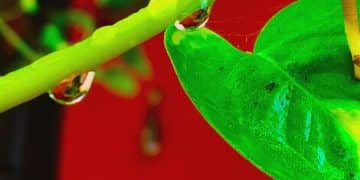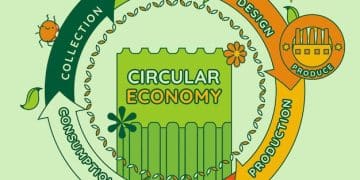Conserve Water at Home: Save Water, Save Money
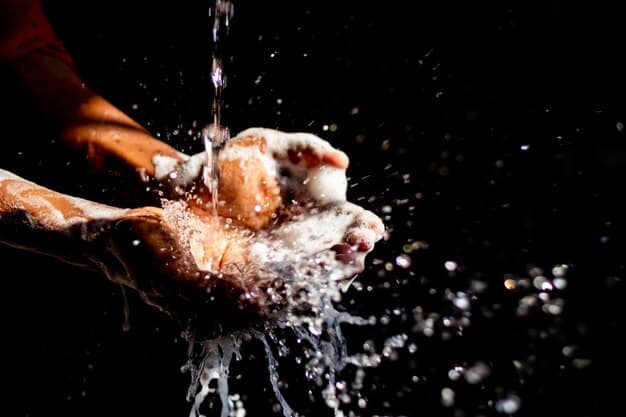
Achieving significant household water savings involves a multifaceted approach, from smart appliance choices and mindful daily habits to addressing leaks and optimizing outdoor water use, ultimately leading to substantial reductions in utility bills.
In an era where sustainability and financial prudence go hand-in-hand, understanding how to conserve water at home and save up to 30% on your bill? is more relevant than ever. This isn’t just about environmental responsibility; it’s also about realizing tangible financial benefits through simple yet effective changes in your daily routines and home infrastructure.
The Hidden Costs of Water Waste: Beyond the Bill
Many homeowners underestimate the true cost of water waste, extending far beyond the monthly utility bill. While the direct financial impact is immediate, the broader implications affect infrastructure, energy consumption, and environmental health.
Each drop of wasted water represents not only the water itself but also the energy used to treat it, pump it to your home, and then potentially heat it. Addressing water waste means tackling these hidden costs head-on, promoting a more efficient and sustainable household.
Understanding Your Water Footprint
Before diving into conservation methods, it’s crucial to understand your current water consumption habits. Many people are surprised to learn how much water goes into seemingly small activities. From long showers to inefficient toilets, cumulative daily actions contribute significantly to your overall water footprint.
- Identify major water-consuming activities in your home.
- Review past water bills to track usage patterns and identify spikes.
- Consider conducting a home water audit.
A water audit can be as simple as checking for leaks or as comprehensive as calculating water usage for each appliance. Tools and resources are available from local utility companies or environmental agencies that provide detailed guidance on performing such audits. This foundational understanding equips you with the knowledge to target specific areas for improvement, ensuring your conservation efforts are both effective and efficient.
Environmental and Community Impact
Beyond personal financial savings, reducing water consumption has a profound impact on local ecosystems and community resources. Water scarcity is a growing global concern, and even in regions with abundant water, the infrastructure required to deliver clean water to homes is resource-intensive.
Maintaining healthy water systems supports biodiversity and ensures a stable supply for agriculture and industry. When communities conserve water, it reduces the strain on local treatment plants and distribution networks, potentially delaying costly infrastructure upgrades that are funded by taxpayers. Every gallon saved contributes to regional water security, making communities more resilient to droughts and climate change effects. This collective effort safeguards natural habitats, promotes healthier river systems, and sustains local economies, demonstrating that individual actions have significant ripple effects.
In essence, conserving water is an act of communal responsibility, contributing to broader environmental health and the well-being of future generations.
By recognizing these hidden costs and broader impacts, you can approach water conservation not just as a task but as an integral part of responsible home management.
Advanced Strategies for Indoor Water Conservation
Indoor water use accounts for the majority of household consumption. Implementing advanced strategies can lead to significant reductions, often without sacrificing comfort or convenience. The key lies in understanding where water is used most and optimizing those areas.
From the bathroom to the kitchen and laundry room, countless opportunities exist to integrate water-saving technologies and habits into your daily routine. Many of these solutions are surprisingly affordable and offer quick returns on investment through reduced bills.
Bathroom: The Highest Water Consumer
The bathroom is typically the largest contributor to household water usage, primarily due to toilets and showers. Upgrading fixtures here can yield substantial savings.
- Toilets: Replace old, inefficient toilets with modern, low-flow or dual-flush models. These can reduce water usage per flush from 3.5-7 gallons down to 1.28 gallons or less.
- Showerheads: Install low-flow showerheads that deliver a powerful spray with less water. Look for models certified by EPA’s WaterSense program, which use 2.0 gallons per minute (GPM) or less, compared to older models that might use 5.0 GPM.
- Faucets: Add aerators to bathroom faucets. These inexpensive devices reduce flow by mixing air with water, providing sufficient pressure for washing while using less water.
Beyond fixture upgrades, behavioral changes in the bathroom are equally important. Taking shorter showers, turning off the tap while brushing teeth, and avoiding using the toilet as a wastebasket are simple, yet effective, habits that collectively make a considerable difference.
Kitchen and Laundry Room Efficiency
These areas, though often overlooked, also present significant opportunities for water saving. Smart appliance choices and mindful practices are essential.
- Dishwashers: Only run your dishwasher when it’s full. Modern dishwashers are more water-efficient than handwashing, especially if they are Energy Star certified.
- Washing Machines: Choose high-efficiency (HE) washing machines. These machines use significantly less water and energy than traditional agitator models. Always run full loads, or use the appropriate load size setting if your machine offers it.
- Faucets: Similar to bathroom faucets, kitchen faucet aerators can reduce water flow. When washing dishes by hand, plug the sink instead of letting water run continuously.
Furthermore, consider collecting vegetable rinse water to use for watering houseplants. Small, consistent efforts in these high-traffic areas accumulate into noticeable savings on your water bill over time. The cumulative effect of these seemingly minor adjustments can be quite substantial, leading to a much more efficient use of water resources in your home.
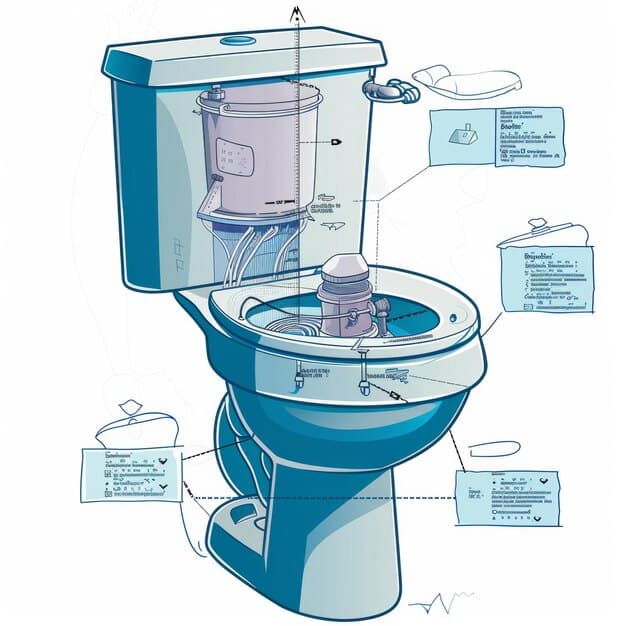
By prioritizing upgrades and fostering conscious habits in these key indoor areas, you can significantly reduce your household’s water consumption, contributing to both environmental preservation and financial well-being.
Smart Outdoor Water Management for a Thriving Landscape
Outdoor water use, primarily for landscaping, can account for a substantial portion of a household’s total consumption, especially in warmer climates. Implementing smart outdoor water management strategies can dramatically reduce this usage without compromising the health or aesthetics of your lawn and garden.
These strategies encompass a range of practices, from efficient irrigation techniques to drought-tolerant landscaping choices, all designed to maximize water efficiency and minimize waste.
Efficient Irrigation Systems
Traditional irrigation methods often lead to water waste through evaporation, runoff, and overwatering. Modern, efficient systems are designed to deliver water precisely where and when it’s needed.
- Drip Irrigation: Install drip irrigation for garden beds, trees, and shrubs. This system delivers water directly to the plant roots, minimizing evaporation and runoff.
- Smart Controllers: Upgrade to smart irrigation controllers that use local weather data, soil moisture sensors, and plant-specific needs to adjust watering schedules automatically.
- Timers: Even with basic sprinklers, using a timer prevents overwatering and ensures irrigation happens during optimal times (early morning) to reduce evaporation.
Regular maintenance of your irrigation system is also crucial. Check for leaks, broken sprinkler heads, or clogged emitters regularly. A small, undetected leak in your irrigation system can waste thousands of gallons of water over a season, negating any efficiency efforts elsewhere.
Lawn Care Practices and Xeriscaping
Your lawn can be a major water guzzler, but with proper care and strategic landscaping, you can significantly reduce its thirst.
Adjusting your lawn care practices can also contribute to substantial water savings. Set your mower blades higher to encourage deeper root growth, which in turn helps your lawn become more drought-resistant. Aerating your lawn once a year improves infiltration and reduces runoff, allowing water to penetrate the soil more effectively.
- Xeriscaping: Consider converting parts of your lawn to xeriscaping – landscaping with drought-tolerant plants native to your region. These plants require minimal irrigation once established.
- Mulch: Apply a layer of organic mulch around plants and in garden beds. Mulch helps retain soil moisture, suppresses weeds, and moderates soil temperature, reducing the need for frequent watering.
- Rain Barrels: Collect rainwater from your roof using rain barrels. This captured water can then be used for irrigation, providing a free and sustainable water source for your garden.
By combining efficient irrigation with smart landscaping choices and responsible lawn care, you can maintain a beautiful outdoor space while drastically cutting down on your water consumption and utility bills.
Leak Detection and Repair: Stopping Silent Water Waste
One of the most insidious forms of water waste in any home is the undetected leak. A seemingly minor drip can lead to hundreds, if not thousands, of gallons of wasted water over time, dramatically inflating your utility bill and potentially causing significant property damage. Identifying and repairing these silent water guzzlers is a straightforward yet highly effective conservation strategy.
Many homeowners are unaware they have leaks until they receive an unusually high water bill. Proactive leak detection is crucial for both water conservation and home maintenance.
Checking for Common Leaks
Leaks can occur virtually anywhere water lines run, but some areas are more prone than others. Knowing where to look can help you quickly pinpoint the source of waste.
- Toilets: A running or phantom-flushing toilet is a common culprit. Add a few drops of food coloring to the toilet tank. If, without flushing, the color appears in the bowl within 15-20 minutes, you have a leak.
- Faucets: Visually inspect all indoor and outdoor faucets for drips. Even a slow drip can waste dozens of gallons per day.
- Showerheads: Check showerheads while not in use. Any persistent dripping indicates a minor leak that needs attention.
These simple visual checks are your first line of defense. Many minor leaks can be fixed with basic plumbing knowledge and inexpensive parts, such as washers or O-rings.
Advanced Leak Detection Methods
Some leaks are not visible and require a more systematic approach to detect. These silent leaks often occur in walls, under foundations, or in underground irrigation lines.
The first step in detecting a hidden leak is to perform a meter check. Turn off all water-using appliances and faucets in your home. Then, check your water meter. If the meter’s dial is still moving (or the digital reading is increasing), you likely have a leak somewhere on your property. This test acts as a general indicator, confirming if a hidden leak exists without specifying its location.
For more pervasive or difficult-to-find leaks, consider investing in professional leak detection services. Specialists use acoustic sensors and thermal imaging to precisely locate leaks within walls, beneath floors, or underground, minimizing damage during repair. Addressing leaks promptly not only saves water and money but also prevents potential structural damage or mold growth that can result from prolonged moisture exposure.
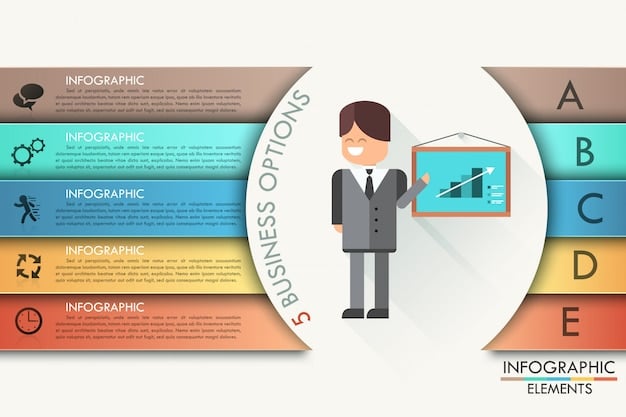
Making leak detection a regular part of your home maintenance routine can prevent considerable water waste and unexpected utility bill spikes, securing both your finances and your peace of mind.
Behavioral Changes: Cultivating Water-Saving Habits
While technological upgrades and fixture replacements play a crucial role in water conservation, the most sustainable changes often stem from adopting mindful behaviors. Cultivating a water-saving mindset among all household members can lead to significant, long-term reductions in consumption without requiring substantial financial investment.
These behavioral shifts are often simple adjustments to daily routines, demonstrating that every drop truly counts when it comes to conserving this precious resource.
Mindful Water Use in Daily Routines
Many common daily activities offer opportunities to save water simply by being more aware and intentional about usage.
- Shorter Showers: Reduce shower time. Aim for 5-7 minute showers instead of 15-20 minute ones. Consider using a timer or turning off the water while lathering.
- Turn Off the Tap: Don’t let water run unnecessarily. Turn off the faucet while brushing teeth, shaving, or scrubbing dishes.
- Full Loads: Only run dishwashers and washing machines when they are completely full. This maximizes the efficiency of each cycle.
These small changes, when practiced consistently by everyone in the household, add up to substantial daily savings. They require a shift in habit, but the benefits quickly become apparent on your water bill.
Rethinking Water in the Kitchen and Garden
Beyond the bathroom, the kitchen and garden offer unique opportunities for more conscious water use patterns.
In the kitchen, instead of letting the faucet run to thaw frozen foods, plan ahead by moving them to the refrigerator overnight. When washing fruits and vegetables, use a basin of water instead of letting water run continuously. The water from rinsing can then be reused for watering plants, further maximizing its utility.
- Dishwashing Habits: Instead of rinsing every dish under running water before loading it into the dishwasher, scrape food scraps into the trash or compost. Most modern dishwashers can handle unrinsed dishes effectively.
- Smart Garden Watering: Water plants close to the root zone to minimize evaporation. Water early in the morning to reduce water loss. Observe your plants; they don’t always need water every day. Feel the soil moisture before watering.
- Rainwater Harvesting for Plants: Place buckets or rain barrels to collect rainwater from downspouts. This naturally soft water is excellent for plants and requires no additional cost.
Instilling these water-saving behaviors across all aspects of home life not only reduces utility bills but also fosters a deeper appreciation for water as a finite and valuable resource. These behavioral changes reinforce the impact of technological upgrades, creating a holistic approach to water conservation.
Policy and Community Initiatives Supporting Water Conservation
While individual and household efforts are crucial for water conservation, broader impact often stems from supportive policy and community-level initiatives. Governments, utility companies, and local organizations play a significant role in encouraging water-saving practices through incentives, educational programs, and regulations.
Understanding these external factors can help homeowners leverage available resources and contribute to larger conservation goals, making the journey towards significant water savings more accessible and impactful.
Rebates and Incentive Programs
Many utility companies and state or local governments offer financial incentives to encourage water-efficient upgrades. These programs can significantly offset the cost of new appliances and fixtures, making smart choices more financially appealing.
- Appliance Rebates: Look for rebates on WaterSense-labeled toilets, showerheads, and high-efficiency washing machines.
- Landscape Conversion Programs: Some areas offer incentives for converting water-intensive lawns to drought-tolerant landscaping.
- Rain Barrel/Cistern Rebates: Programs may provide financial assistance for installing systems to collect rainwater for irrigation.
Checking your local utility provider’s website or state environmental agency is often the best first step to discover available programs. These incentives not only reduce upfront costs but also reinforce the financial benefits of water conservation over time.
Educational Outreach and Public Awareness Campaigns
Knowledge is power when it comes to conservation. Community-based educational programs and awareness campaigns help spread best practices and foster a collective commitment to water saving.
These initiatives frequently provide hands-on workshops, seminars, and online resources that teach citizens about efficient water use. They disseminate information on topics like smart irrigation scheduling, native plant selection, and how to detect leaks. By empowering residents with practical knowledge and tools, these campaigns foster a culture of conservation that transcends individual homes and benefits the entire community, ensuring widespread adoption of water-saving habits and practices.
- Public Workshops: Attend free workshops on topics like xeriscaping, drip irrigation installation, or home water audits.
- Informational Websites: Utilize online resources from local water authorities that offer tips, tools, and data on regional water conservation efforts.
- Community Events: Participate in local events focused on environmental sustainability, often featuring exhibitors promoting water-efficient products and services.
These campaigns foster a collective consciousness around water scarcity and the importance of conservation, encouraging a more sustainable approach to water use across the community.
Water-Efficient Building Codes and Regulations
Beyond incentives, some areas implement building codes and regulations that mandate water-efficient fixtures in new construction or during renovations. These regulations ensure a baseline level of water efficiency for new homes and businesses.
Compliance with these codes contributes to a cumulative reduction in regional water demand. For older homes, homeowners should still consider voluntary upgrades to meet or exceed these standards, not only for environmental benefits but also for higher property value and lower operational costs. As climate patterns shift and water resources become more strained, the role of these policies is expected to expand, further integrating water efficiency into the fabric of urban and suburban development.
By engaging with and benefiting from these policy and community initiatives, households can amplify their individual water savings and contribute to a more resilient water future for everyone.
Measuring Your Progress and Maximizing Savings
Successfully conserving water at home isn’t just about implementing new habits or technologies; it also involves actively measuring your progress to ensure your efforts are yielding results. By understanding your consumption patterns and making informed adjustments, you can truly maximize your savings and reduce your environmental footprint.
This section explores practical ways to track water usage, set realistic goals, and continuously optimize your water-saving strategies.
Understanding Your Water Bill
Your water bill is more than just a payment request—it’s a detailed report of your household’s water consumption. Learning to read and interpret it is the first step toward effective measurement.
Look for consumption data, usually presented in gallons or cubic feet, and compare it to previous months or the same period in prior years. Many bills also show usage trends or compare your consumption to average household usage in your area. This comparative data can highlight unusually high usage, indicating potential leaks or areas where conservation efforts are needed most. Understanding the billing structure, including tiered rates, can also motivate conservation by showing how much more expensive water becomes beyond a certain usage threshold.
- Track Monthly Usage: Keep a record of your water consumption each month. Many utility companies offer online portals where you can easily view your usage history.
- Identify Spikes: Notice any sudden increases in usage. These could indicate a new leak, a change in watering habits, or a particularly water-intensive activity.
- Compare to Averages: See how your household’s usage compares to similar-sized homes in your area. This can provide context for your efforts.
By regularly reviewing your water bills, you gain valuable insights into your consumption habits and the effectiveness of your conservation efforts.
Setting Goals and Celebrating Achievements
Establishing clear, measurable goals for water reduction can provide motivation and a sense of accomplishment. Begin with small, achievable targets and gradually increase them as you become more efficient.
For example, aim to reduce your family’s daily shower time by two minutes, or commit to running the dishwasher only when it’s completely full. Celebrate milestones, such as a lower-than-expected water bill or successfully fixing a dripping faucet. Positive reinforcement encourages continued effort. Share your successes with your household members to foster a collective commitment to water conservation. Tracking progress, even in small increments, reinforces the positive impact of your actions and helps maintain momentum towards larger savings.
- Realistic Targets: Set achievable short-term and long-term water-saving goals (e.g., reduce usage by 10% next month, or by 20% by year-end).
- Household Involvement: Engage all family members in setting goals and finding ways to contribute.
- Rewarding Progress: Acknowledge and celebrate reductions in water usage. Perhaps use a portion of the savings for a family treat.
Regularly reviewing your goals and adjusting your strategies ensures that you are continuously optimizing your water conservation efforts. This iterative process allows for continuous improvement and sustained savings, leading to long-term financial and environmental benefits.
| Key Point | Brief Description |
|---|---|
| 🚿 Efficient Fixtures | Upgrade to low-flow toilets, showerheads, and faucet aerators for significant indoor savings. |
| 💧 Leak Detection | Regularly check for and fix drips and hidden leaks to stop silent water waste. |
| 🏡 Smart Landscaping | Implement drip irrigation, xeriscaping, and mulching to reduce outdoor water use. |
| 🤲 Behavioral Habits | Adopt mindful routines like shorter showers and full loads for appliances. |
Frequently Asked Questions About Water Conservation
In most homes, toilets are the biggest water-waster, especially older models that can use 3.5 to 7 gallons per flush. Upgrading to a WaterSense-labeled low-flow (1.28 gallons per flush) or dual-flush toilet can significantly reduce this consumption. After toilets, outdoor irrigation tends to be the next major water-consuming activity, particularly during warmer months.
Yes, water-saving appliances are generally a worthwhile investment. While the initial cost might be higher, the long-term savings on your water (and often energy) bills can quickly recoup the expense. Appliances like high-efficiency washing machines and dishwashers use less water per cycle, leading to substantial savings over their lifespan. Many utility companies also offer rebates, further reducing the upfront cost.
It’s advisable to check for leaks in your home at least once every six months, or whenever you notice an unexplained spike in your water bill. Performing a simple meter test (turning off all water and checking if your meter moves) can quickly identify hidden leaks. Regularly checking toilets, faucets, and irrigation systems for visible drips or wet spots is also a good proactive measure.
Absolutely. Simple behavioral changes, when practiced consistently by all household members, can lead to significant water savings. Taking shorter showers, turning off the tap while brushing teeth, and only running full loads for dishwashers and washing machines are examples of habits that collectively save hundreds, if not thousands, of gallons of water annually. These changes are cost-free and immediately impactful.
The best plants for a water-efficient garden are those native to your local climate or known to be drought-tolerant. These typically require less supplemental irrigation once established. Examples often include succulents, ornamental grasses, and many Mediterranean or desert-adapted shrubs and perennials. Researching local xeriscaping guides or consulting a local nursery can provide specific recommendations for your region.
Conclusion
Mastering how to conserve water at home and saving up to 30% on your bill is an achievable and rewarding endeavor that blends environmental stewardship with financial astuteness. By integrating smart technologies, adopting mindful habits, and proactively addressing leaks, every household can significantly reduce its water footprint. The journey towards water efficiency is continuous, involving conscious choices and regular monitoring, but its benefits—from reduced utility costs to a healthier planet—are undeniably profound and long-lasting.


